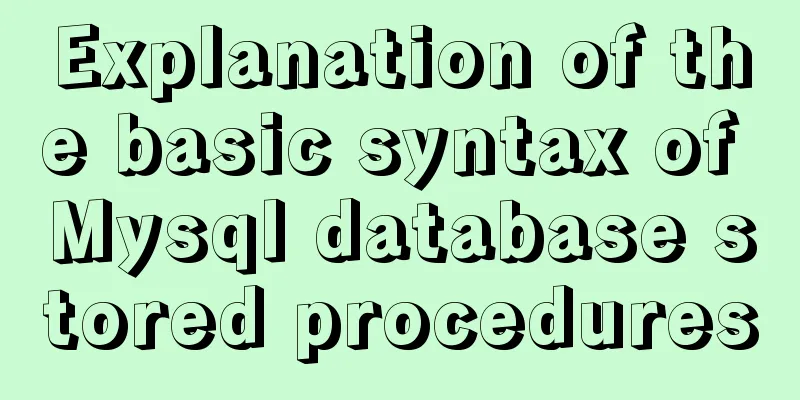Briefly describe the MySQL InnoDB storage engine

|
Preface: The storage engine is the core of the database. For MySQL, the storage engine runs in the form of a plug-in. Although MySQL supports a wide variety of storage engines, the most commonly used one is InnoDB. This article will mainly introduce the knowledge related to the InnoDB storage engine. 1. Introduction to InnoDB After MySQL version 5.5, the default storage engine is InnoDB. InnoDB is a general-purpose storage engine that combines high reliability and high performance. In MySQL 5.7, unless you have configured a different default storage engine, executing a CREATE TABLE statement without specifying an ENGINE will create an InnoDB table. # View the storage engines supported by MySQLmysql> show engines; +--------------------+---------+----------------------------------------------------------------+--------------+------+------------+ | Engine | Support | Comment | Transactions | XA | Savepoints | +--------------------+---------+----------------------------------------------------------------+--------------+------+------------+ | InnoDB | DEFAULT | Supports transactions, row-level locking, and foreign keys | YES | YES | YES | | MRG_MYISAM | YES | Collection of identical MyISAM tables | NO | NO | NO | | MEMORY | YES | Hash based, stored in memory, useful for temporary tables | NO | NO | NO | | BLACKHOLE | YES | /dev/null storage engine (anything you write to it disappears) | NO | NO | NO | | MyISAM | YES | MyISAM storage engine | NO | NO | NO | | CSV | YES | CSV storage engine | NO | NO | NO | | ARCHIVE | YES | Archive storage engine | NO | NO | NO | | PERFORMANCE_SCHEMA | YES | Performance Schema | NO | NO | NO | | FEDERATED | NO | Federated MySQL storage engine | NULL | NULL | NULL | +--------------------+---------+----------------------------------------------------------------+--------------+------+------------+ # View the default storage enginemysql> show variables like 'default_storage_engine'; +------------------------+--------+ | Variable_name | Value | +------------------------+--------+ | default_storage_engine | InnoDB | +------------------------+--------+ 2. InnoDB Advantages The reason why InnoDB is so popular is mainly due to its many functional advantages. 1) Support services The most important point about InnoDB is that it supports transactions. It can be said that this is a very important reason why InnoDB has become the most popular storage engine in MySQL. In addition, InnoDB also implements four isolation levels (READ UNCOMMITTED, READ COMMITTED, REPEATABLE READ, and SERIALIZABLE), making support for transactions more flexible. 2) Good disaster recovery InnoDB ensures data security through commit, rollback, and crash-recovery. Specifically, crash-recovery means that if the server crashes due to hardware or software problems, no matter what the data is like at the time, after restarting MySQL, InnoDB will automatically recover to the state before the crash. 3) Use row-level locks InnoDB changes the locking mechanism of MyISAM and implements row locking. Although the row lock mechanism of InnoDB is implemented through indexes, most SQL statements in the database use indexes to retrieve data. The row locking mechanism also greatly enhances InnoDB's competitiveness in environments with high concurrency pressure. 4) Implemented buffer processing InnoDB provides a dedicated buffer pool and implements buffer management. It can not only buffer indexes but also buffer data. Frequently used data can be processed directly from memory, which is faster than obtaining data from disk. On a dedicated database server, it is common to allocate up to 80% of physical memory to the buffer pool. 5) Support foreign keys InnoDB supports foreign key constraints, checks on foreign keys, inserts, updates, and deletes to ensure data integrity. When storing data in a table, each table is stored in the order of the primary key. If the primary key is not explicitly specified when defining the table, InnoDB generates a 6-byte ROWID for each row and uses it as the primary key. Summarize: This article briefly introduces the InnoDB storage engine and its advantages. If you want to learn MySQL in depth, InnoDB is definitely a key knowledge that you cannot avoid. There is a lot more content about InnoDB, and I will write more about it later if I have the chance. The above is a brief description of the details of the MySQL InnoDB storage engine. For more information about the MySQL InnoDB storage engine, please pay attention to other related articles on 123WORDPRESS.COM! You may also be interested in:
|
<<: Vue3 Documentation Quick Start
>>: Solution to Linux QT Kit missing and Version empty problem
Recommend
4 ways to avoid duplicate insertion of data in Mysql
The most common way is to set a primary key or un...
Abbreviation of HTML DOCTYPE
If your DOCTYPE is as follows: Copy code The code ...
Implementation and usage scenarios of JS anti-shake throttling function
Table of contents 1. What is Function Anti-shake?...
Detailed explanation of JavaScript progress management
Table of contents Preface question principle test...
A brief talk about JavaScript parasitic composition inheritance
Composition inheritance Combination inheritance i...
Detailed explanation of the pitfalls of MySQL 8.0
I updated MySQL 8.0 today. The first problem: Nav...
MySQL startup error InnoDB: Unable to lock/ibdata1 error
An error message appears when MySQL is started in...
Nodejs module system source code analysis
Table of contents Overview CommonJS Specification...
Detailed tutorial on migrating the home directory to a new partition under Ubuntu
When the user's home directory becomes larger...
Node+Express test server performance
Table of contents 1 Test Environment 1.1 Server H...
How to mount a disk in Linux and set it to automatically mount on boot
Knowing that everyone's time is precious, I w...
Detailed explanation of character sets and validation rules in MySQL
1Several common character sets In MySQL, the most...
Design: A willful designer
<br />Years of professional art design educa...
Introduction to Linux system swap space
Swap space is a common aspect of computing today,...
Detailed steps for remote deployment of MySQL database on Linux
Linux remote deployment of MySQL database, for yo...









